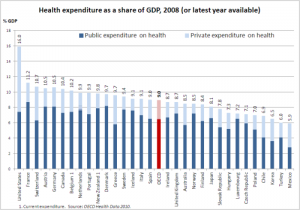The 30 most developed countries, on average, allocated 9% of their national budgets to health care in 2008, up from 7.8% in 2000. The U.S., in contrast, spent 16% of GDP on health care, nearly one-half of which came from public treasury coffers.
The graph illustrates the statistics for each OECD member nation and the share of health care paid by public and private sectors. Note that the light-blue bar segment for the U.S. is a far larger proportion of the total bar compared to other countries: that’s the private sector’s contribution to health spending versus the dark blue, government portion.
Welcome to the 2010 version of OECD Health Data, which comes from the Organization of Economic Cooperation and Development (OECD) which collects data from 31 nations that are committed to, as their mission says, “democracy and the market economy.”
The OECD points to 3 key spending drivers in health care: technology innovation, population aging, and public expectations for their national health systems.
The OECD warns about the dark-blue financial commitment of government spending on health care: given the growing budget deficits in so many countries, governments’ ability to continue spending in health care will be hamstrung by competing budget priorities. At the same time, public expectations, aging and new technologies will be countervailing forces that challenge rationalizing health spending in these countries.
On the technology front, OECD finds that digital imaging modalities have been adopted to the tune of over twice the number of MRI units per capita in 2008 (13) versus 6 units per capita in 2000 — highest in Japan, the U.S., Italy and Greece.
Health Populi’s Hot Points: The annual release of OECD data leads to inevitable discussions about which nation’s health care system is “best.” Instead of asking that question, Health Populi thinks about value-for-money. For the U.S., budget deficits and public expectations for the health system are squaring off as the nation spends nearly 1 in 5 dollars in the economy on health care.
Health reform as written in the Patient Protection and Affordable Care Act (PPACA) begins — just begins — to chip as this iceberg in the form of comparative effectiveness regimes and pilot programs that seek to manage population health and reward care based on health outcomes. But this will be a bumpy, long ride where PPACA in 2014 is but a first step in the marathon that lead to the rational spending, new-new U.S. High Performance Health System that The Commonwealth Fund talks about.





 I'm in amazing company here with other #digitalhealth innovators, thinkers and doers. Thank you to Cristian Cortez Fernandez and Zallud for this recognition; I'm grateful.
I'm in amazing company here with other #digitalhealth innovators, thinkers and doers. Thank you to Cristian Cortez Fernandez and Zallud for this recognition; I'm grateful. Jane was named as a member of the AHIP 2024 Advisory Board, joining some valued colleagues to prepare for the challenges and opportunities facing health plans, systems, and other industry stakeholders.
Jane was named as a member of the AHIP 2024 Advisory Board, joining some valued colleagues to prepare for the challenges and opportunities facing health plans, systems, and other industry stakeholders.  Join Jane at AHIP's annual meeting in Las Vegas: I'll be speaking, moderating a panel, and providing thought leadership on health consumers and bolstering equity, empowerment, and self-care.
Join Jane at AHIP's annual meeting in Las Vegas: I'll be speaking, moderating a panel, and providing thought leadership on health consumers and bolstering equity, empowerment, and self-care.